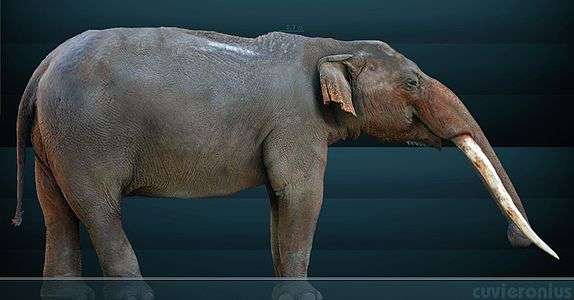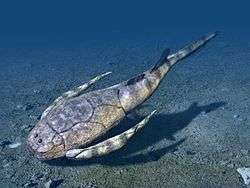Aotus dindensis
| Aotus dindensis | |
|---|---|
| Scientific classification | |
| Kingdom: | Animalia |
| Phylum: | Chordata |
| Class: | Mammalia |
| Order: | Primates |
| Family: | Aotidae |
| Genus: | Aotus |
| Binomial name | |
| Aotus dindensis Setoguchi & Rosenberger 1987 | |
Aotus dindensis is an extinct species of New World monkeys in the genus Aotus from the Middle Miocene (Laventan in the South American land mammal ages; 13.8 to 11.8 Ma). Its remains have been found at the Konzentrat-Lagerstätte of La Venta in the Honda Group of Colombia.[1]
Etymology
The species has been named after the locality its fossils have been found, the El Dinde site of the "Monkey Unit" in the Honda Group, Colombia.[2][3]
Description
Fossils of Aotus dindensis were discovered in 1986 in the Honda Group,[2] that has been dated to the Laventan, about 12.5 to 12.1 Ma.[4] The species is considered the oldest member of Aotus,[5] recognised for the almost identical mandibular and dental morphology.[6] It may be the ancestor of the extant Aotus species of South America,[7] though other authors consider the species a synonym of Mohanamico.[8]
The material consists of a left hemimandible, a left maxillary fragment preserving roots and lingual half of M3.[2] The dental parts of Aotus dindensis was more primitive than that of extant Aotus. As the night monkeys of today, Aotus dindensis probably had a similar nocturnal lifestyle, with a less specialised diet.[9] A body mass of 1,054 grams (2.324 lb) has been estimated for Aotus dindensis.[10]
The locomotion of Aotus, Callicebus, Cebupithecia and the Argentinian genus Dolichocebus has been described as primarily quadrupedal with some leaping.[11][5]
Evolution
The evolutionary split in New World monkeys between Callitrichidae and Aotus has been estimated at 17.5 Ma.[12] The Early Miocene origin for the genus Aotus is the longest of primates, with only Macaca traceable to the Late Miocene, approximately eight million years ago.[13]
Habitat
The Honda Group, and more precisely the "Monkey Beds", are the richest site for fossil primates in South America.[14] It has been argued that the monkeys of the Honda Group were living in habitat that was in contact with the Amazon and Orinoco Basins, and that La Venta itself was probably seasonally dry forest.[15] From the same level as where Aotus dindensis has been found, also fossils of Cebupithecia, Micodon, Mohanamico, Saimiri annectens, Saimiri fieldsi and Stirtonia tatacoensis have been uncovered.[16][17][18]
See also
References
- ↑ Aotus dindensis at Fossilworks.org
- 1 2 3 Setoguchi & Rosenberger, 1988, p.1
- ↑ Gebo et al., 1990, p.737
- ↑ Defler, 2009, p.404
- 1 2 Gebo et al., 1990, p.745
- ↑ Pérez et al., 2013, p.4
- ↑ Defler & Bueno, 2007, p.65
- ↑ Defler, 2004, p.34
- ↑ Setoguchi & Rosenberger, 1988, p.3
- ↑ Silvestro et al., 2017, p.14
- ↑ Gebo et al., 1990, p.744
- ↑ Takai et al., 2001, p.304
- ↑ Setoguchi & Rosenberger, 1988, p.4
- ↑ Rosenberger & Hartwig, 2001, p.3
- ↑ Lynch Alfaro et al., 2015, p.520
- ↑ Luchterhand et al., 1986, p.1753
- ↑ Wheeler, 2010, p.133
- ↑ Setoguchi et al., 1986, p.762
Bibliography
- Defler, Thomas R. 2009. Some evolutionary tendencies of neotropical primates. Acta Biológica Colombiana 14. 399–414. Accessed 2017-09-24.
- Defler, Thomas. 2004. Historia natural de los primates colombianos, 1–613. Universidad Nacional de Colombia. Accessed 2017-09-24.
- Defler, Thomas R., and Marta L. Bueno. 2007. Aotus Diversity and the Species Problem. Primate Conservation 22. 55–70. Accessed 2017-09-24.
- Gebo, Daniel L.; Marian Dagosto; Alfred L. Rosenberger, and Takeshi Setoguchi. 1990. New platyrrhine tali from La Venta, Colombia. Journal of Human Evolution 19. 737–746. Accessed 2017-09-24.
- Luchterhand, Kubet; Richard F. Kay, and Richard H. Madden. 1986. Mohanamico hershkovitzi, gen. et sp. nov., un primate du Miocene moyen d' Amerique du Sud. Comptes rendus de l'Académie des sciences 303. 1753–1758. Accessed 2017-09-24.
- Lynch Alfaro, Jessica W.; Liliana Cortés Ortiz; Anthony Di Fiore, and Jean P. Boubli. 2015. Special issue: Comparative biogeography of Neotropical primates. Molecular Phylogenetics and Evolution 82. 518–529. Accessed 2017-09-24.
- Pérez, S. Iván; Marcelo F. Tejedor; Nelson M. Novo, and Leandro Aristide. 2013. Divergence Times and the Evolutionary Radiation of New World Monkeys (Platyrrhini, Primates): An Analysis of Fossil and Molecular Data. PLOS One 8. 1–16. Accessed 2017-09-24.
- Rosenberger, Alfred L., and Walter Carl Hartwig. 2001. New World Monkeys. Encyclopedia of Life Sciences _. 1–4. Accessed 2017-09-24.
- Setoguchi, Takeshi, and Alfred L. Rosenberger. 1988. A fossil owl monkey from La Venta, Colombia. Kyoto University overseas research reports of New World monkeys 6. 1–6. Accessed 2017-09-24.
- Setoguchi, Takeshi; Nobuo Shigehara; Alfred L. Rosenberger, and Alberto Cadena G. 1986. Primate fauna from the Miocene La Venta, in the Tatacoa Desert, Department of Huila, Colombia. Caldasia XV. 761–773. Accessed 2017-09-24.
- Silvestro, Daniele; Marcelo F. Tejedor; Martha L. Serrano Serrano; Oriane Loiseau; Victor Rossier; Jonathan Rolland; Alexander Zizka; Alexandre Antonelli, and Nicolas Salamin. 2017. Evolutionary history of New World monkeys revealed by molecular and fossil data. BioRxiv _. 1–32. Accessed 2017-09-24.
- Takai, Masanaru; Federico Anaya; Hisashi Suzuki; Nobuo Shigehara, and Takeshi Setoguchi. 2001. A New Platyrrhine from the Middle Miocene of La Venta, Colombia, and the Phyletic Position of Callicebinae. Anthropological Science, Tokyo 109.4. 289–307. Accessed 2017-09-24.
- Wheeler, Brandon. 2010. Community ecology of the Middle Miocene primates of La Venta, Colombia: the relationship between ecological diversity, divergence time, and phylogenetic richness. Primates 51.2. 131–138. Accessed 2017-09-24.
Further reading
- Fleagle, John G., and Alfred L. Rosenberger. 2013. The Platyrrhine Fossil Record, 1–256. Elsevier ISBN 9781483267074. Accessed 2017-10-21.
- Hartwig, W.C., and D.J. Meldrum. 2002. The Primate Fossil Record - Miocene platyrrhines of the northern Neotropics, 175–188. Cambridge University Press, ISBN 978-0-521-08141-2. Accessed 2017-09-24.


.jpg)
